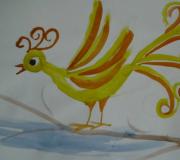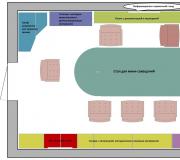The smallest deer is the Pudu. Pudu: The tiniest deer in the world The smallest pudu deer
Pudu Deer- These are unique, interesting animals. They are the smallest member of the deer family. In nature, this type of artiodactyl is found in two species - southern and northern. The difference between them can only be found in size. The lifestyle, nutrition and habits of both southern and northern Pudus are similar.
Description of animals
At the withers, Pudu deer reach a height of 30–35 cm. Body length however, it does not exceed 90 cm. The average weight of dwarf deer varies between 7–10 kg. Cubs are born with a height of 15 cm and a weight of 1.5 kg.
Body type Pudu's is stocky. The back has an arched appearance. Pudus have a short neck, a small head and rounded ears covered with thickly growing hair, which is unusual for ordinary deer. The coat color is grey-brown. Miniature artiodactyls also have horns. However, it is impossible to see them as a couple due to small sizes and thick wool. Especially if we're talking about about the female (horns 1–2 cm). The male's horn length does not exceed 10 cm.
Nutrition
The Pudu deer's diet consists of vegetation.
They eat:
- leaves of bushes and trees;
- juicy grass;
- young shoots;
- berries;
- fruits fallen from trees.
However, a delicacy for Pudu deer are fuchsia algae. But it’s not easy for small animals to get such a treat. For algae you have to go to the sea, where a lot of dangerous troubles await Pudu. And in order to profit from regular food, miniature deer have to stand on their hind legs and reach for juicy leaves. Animals often bend young shoots to get to younger greenery. A fallen tree becomes a godsend for Pudu deer, which they can easily climb up and profit from the leaves.
Read also:
Reproduction
Sexual maturity of young Pudu deer is reached at the age of 1 year. The mating season of artiodactyls begins in mid-autumn. During this period, males grow new horns (the old ones are shed in June). They flirt with females, placing their heads on their backs and sniffing them. And if the female is ready to mate, fertilization occurs. Pudus carry babies within 7 months. Born measuring 15 cm, small deer quickly gain weight and overtake their parents at the age of 3 months. During this period, the red spots that have been on their sides since birth begin to disappear. This color provides newborn Pudu deer with safety, as they are hidden in the thickets.

Habitat
IN wildlife Pudu deer are found only on Chilos Island and coastal Chile. Although previously the population of pygmy deer lived in many other countries South America(including the western part of the mainland). Pygmy deer hide in the thickets of forests and mountains. They are nocturnal, as they are forced to hide from numerous predators. Even dogs pose a danger to small animals.
Along with predatory animals, the Pudu deer population is also threatened by people. Excessive hunting and deforestation, which are the natural habitat of low-growing deer, humanity is gradually reducing the number of dwarf animals. Therefore, Pudu deer are included in the Red Book and are participants in the program for breeding the genus in zoos (EEP) and national parks in many countries of America and Europe.
Reindeer are widespread on all continents except the Arctic and live in tundras, forests, steppes and forest-steppes. It is not so easy to notice them - the color of a deer reliably hides it from the eyes of strangers, and natural caution, a keen sense of smell and vision allow the animals to take refuge in the thickets long before a person approaches. Deer species vary in color, size, shape of antlers and habitat.
About deer
The deer family includes three subfamilies, which consist of 19 genera and 51 species.
Red deer
The largest representative of the family is the red deer. The weight of an adult can reach 300 kg. He also has the most proportional body. Next come the northern ones, which can weigh up to 200 kg. And the smallest representative, the pudú, is found in nature only in the forests of South America and weighs no more than 10 kg.

The description of a deer, regardless of its height, weight, type and age, can be compiled as follows: an elegant animal with long and slender legs, a long proportional neck and a small head with expressive eyes, decorated with branched horns. A young deer of any species does not have antlers; they begin to grow only at 7 - 8 months.

White look
The white deer is the most rare breed and is on the verge of extinction. White deer lives in some areas of Siberia and is not very common outside its territory. This is a fairly large animal with developed horns. The white color is due to the presence of a recessive gene that is inherited. Exactly white color plays decisive role in the survival of animals - they are clearly visible in the forest, which makes them easy prey. The basis of the animal’s diet is reindeer moss, as well as leaves, tree bark, branches, and grass. During the winter months, white deer dig up lichen and eat tree branches and acorns.

White deer is an excellent swimmer and can swim several tens of kilometers a day, wandering between islands with fresh greenery or hiding from predators.
American look
White-tailed deer live in the area North America and on the northern part of South. In the last century, animals were exported to Scandinavian countries, where they not only took root, but also began to actively reproduce. The population of this species numbers about 10 million individuals.

The size of the animal depends on the region where it lives: in the north they are larger and more massive. An adult white-tailed deer weighs no more than 150 kg. Knittings are lighter and their weight barely reaches 100 kg. White-tailed deer have two subspecies: Florida island and Columbia. The Florida subspecies does not exceed 60 cm at the withers and weighs only 35 - 40 kg. The Colombian subspecies is slightly larger and lives in the southern states along rivers, as well as in forests with dense bush. Both subspecies are on the verge of extinction.
White-tailed deer come in two colors: they wear grayish-brown fur in winter and brownish-red fur in summer. The upper body is always darker. The tail is white below, dark brown above. When running, the tail is raised high and only the white part is visible.

Males grow luxurious horns throughout the year, while females are hornless. White-tailed deer prefer to live alone, gathering in small groups only during the breeding season. During the rutting season, males start a family of 3-4 females. Pregnancy lasts 7 months and ends with the birth of one to three calves. The calf feeds on its mother's milk for the next three months. The fur of a newborn fawn has white round spots. A young deer spends the first one and a half to two years of its life with its mother, and the first few days hide in tall grass and bushes. The female comes to feed the cub several times a day.

Siberian breeds
Siberian deer or caribou, as it is called on the American continent, is represented by four breeds:
- Nenets,
- Chukotka,
- Evenki,
- Evenskaya
The Nenets Siberian deer has chosen the territory beyond the Urals. The animal is short in stature, with thick brown fur. It is distinguished by its endurance and rather large weight for its height - up to 140 kg in males and up to 100 in females. Local residents use these animals for transportation - a reindeer team is capable of covering many tens of kilometers a day, even through loose and deep snow.

Chukotka Siberian deer is dark brown in color. Short, capable of gaining weight quickly. In the winter months, it tolerates frost well and is able to go for a long time without food if a layer of snow does not allow it to reach the reindeer moss. It lives on tundra plains with little snow cover.

Even Siberian deer lives in the mountainous regions of Kamchatka and the Magadan region. Representatives of this breed weigh only 60 - 65 kg and have a light brown color. Today the population numbers only a few thousand individuals.

The Evenki breed is the first of the domesticated ones. The Siberian deer is easily tamed to the saddle. Animals are bred for meat, milk, antlers.

Smallest species
The smallest deer, the Pudu, lives in the inaccessible forests of Chile, Peru and Ecuador. The animal has a short body, the height at the withers is no more than 40 cm, and Weight Limit male is 10 kg.

Most often there are individuals with a body weight of 5-7 kg. Pudu prefers to live alone, forming pairs only during the breeding season. The animals are very careful and shy, and it is quite difficult to find them in their natural habitat. To escape from predators, the pudú can even climb onto an inclined tree, and in attempts to reach tree branches, it stands on its hind legs.

Pudu is under threat of extinction - tasty meat has made this small deer a desirable prey for predators.
Tiny and incredibly cute puda known as the smallest member of the deer family. Adults grow to the size of a fox terrier: only 36-46 cm at the withers and 6-13 kg. Newborn fawns weigh less than a kilogram and are so small that they can fit in the palm of your hand.
In the area where pudus are found in the wild, there are two subspecies of these. The Northern Pudu lives in the forests of Colombia, Ecuador and Peru. Strictly speaking, he is the smallest deer on the planet.
The maximum height of this cute creature is 35 cm in height, and its weight is 6 kg, which is comparable not even to, but to a pug. Slightly larger than its northern counterpart, the southern pudú lives in Chile and Argentina.
Here it is found both on mountain slopes, at an altitude of up to 2000 m above sea level, and near the coast. Occasionally appearing in open spaces, most of the time the deer hides in the wilds of the local tropical forest.

Pudus have a rather dense build, a rounded body and short legs. Their eyes and ears are small compared to the size of their body, and their tail is almost invisible.
From the age of eight months, young males begin to grow horns, which reach their full size by the age of seven. maximum length 5-10 cm. They have a straight, spike-like shape and, as is customary with other deer, are shed annually and grow back.
Pudus wear a discreet, protective coloration: their coarse fur is grey-brown in color, providing good concealment from predators. At the same time, the lower part of the head, the outer part of the ears and the belly are slightly reddish. The backs of fawns are covered with white spots, which gradually disappear at the age of 3-5 months.
Pudu deer lifestyle
Pudu deer- very cautious and secretive animals, about whose life and habits not much has been found out. Most of the information about them and photo of pudu deer people get it from zoos where they are kept.

In the wild, observing them is difficult, because they favorite places habitat - dense undergrowth and bamboo thickets. More often than not, they move slowly and carefully, often stopping and carefully sniffing the odors.
Pygmy Pudu Deer most active in the morning, late afternoon and evening. He prefers to live alone or in pairs, gathering in numbers of more than two only during the mating season. During the rest of the year, pudus each stick to their own small territory.
Its area is 40-60 acres. Pudu announces its presence to its relatives by leaving piles of droppings near trails and resting places. In addition, like other deer, it has special glands, with the help of the odorous secretion of which it marks its territory. These glands are located on the head, so the pudu rubs its forehead against the trunks of bushes and trees, spreading its smell.
The smallest Pudu deer- an almost defenseless creature. It is also hunted by wild South American cats. With the spread of human civilization, dogs are becoming an increasing threat to the Pudu.

Unfortunately, local farmers let their four-legged guards roam freely through the forests, where they cannot resist the temptation to feast on easy prey. When the Pudu feels anxiety and fear, it makes barking sounds, which, however, cannot make much of an impression on the predator.
Therefore, in case of danger, the animal tries to escape into the dense thicket, moving in sharp zigzags. His small stature and short legs allow him to easily maneuver and penetrate into the most hard to reach places forests. If necessary, the pudú can even climb onto an inclined tree trunk, which is an impressive indicator of agility for an ungulate animal.
Nutrition
Pudu are herbivorous animals that feed on branches and bark, succulent grass and fresh leaves, fallen fruits and seeds. On such a menu they can do without drinking water for a long time, being content with the moisture entering the body with food.

Unfortunately, their small stature often becomes an obstacle that prevents them from reaching tree branches. Therefore, pudus use tricks: they get food while standing on their hind legs, own weight they bend young shoots to the ground, and sometimes use them as a “stand” to reach higher tiers of the forest.
Reproduction and lifespan
Female Pudus become capable of reproduction at the age of six months. Although males reach sexual maturity around the same time, they often remain without a mate until they are two years old, when they are large and strong enough to successfully compete for females.
In the fall, deer look for a mate, and the only cub is born in the spring, after 202-223 days of pregnancy (this time falls in November-January in Southern Hemisphere). At birth, the cub weighs several hundred grams.

In the first days after birth, the tiny fawn hides in a secluded place, and the mother herself visits him from time to time to feed him. After a few weeks, the baby becomes old enough and dexterous to follow its parent. It reaches adult size in three months, but can sometimes remain with its mother for a whole year.
Pudus can live up to 12 years in the wild, and even longer in zoos. The current record is 15 years and nine months. But, unfortunately, due to predators, pygmy deer usually live much shorter lives.

Both subspecies of pudu are included in the “endangered” category in the Red Book. Their natural habitat is shrinking due to overpopulation, Agriculture, deforestation, hunting and other human activities.
Moreover, for the beauty they possess Pudu deer, price turned out to be too big. Fascinated by the touching and exotic appearance of this animal, wealthy people try buy deer puda as an ornamental pet, on which poachers make money without a twinge of conscience.
Therefore, the future of this endangered species in the wild remains uncertain. Although there are already known cases of successful breeding of pudus in zoos, there is no talk of releasing them into the wild. And as long as this is the case, Pudu deer are not destined to become pets.
Deer are always considered beautiful, noble animals. But there are also special types among them. Pudu deer is the tiniest deer in the world. This miniature, graceful animal in the photo resembles a fairy-tale creature: it is so cute and unusual. Where does the Pudu live and what does it eat?
What does the animal look like
Those who see a puda for the first time in a photo or video do not immediately realize that it is a deer. After all, we always associate them with majestic, graceful and fairly large animals. Pudu deer are the complete opposite of their counterparts. He is very small, not at all capable of moving quickly.
Main characteristics:
- Height at withers – no more than 35 cm.
- Weighs between 10-12 kg.
- Body length – 90 cm.
- Unable to run fast.
- Does not have characteristic white spots on the body.
- Instead of luxurious branched antlers, only 10-centimeter horns are visible.
- The physique is massive, squat.

His short legs and wide neck do not add elegance to the deer. All that remains of deer antlers is the name. Short horns are almost invisible, since they are hidden by thick fur on the forehead. By the way, the color is rarely spotted. Most often this animal is brown, dark gray, or red in color. But the fur is very high quality and thick.
Species diversity
In nature there are 2 types. These are the northern and southern pudu deer. The former remain a mystery to scientists today. They have been little studied, are very secretive and live in inaccessible mountainous areas of Ecuador and Colombia. The southern deer has found its home in Chile and parts of Argentina. Only a small detail helps to distinguish these types of animals: the southern one has a tail, and the northern one is tailless.
Attention! These unusual animals are on the verge of extinction. They are protected by the countries in which they live. The animal adapts very poorly in captivity, so this deer is extremely rarely kept in zoos.
Both species are listed in the International. Despite the bans, the local population continues to hunt the animal in order to obtain valuable fur or for profitable illegal sale to private breeders.
Habits and eating habits
This is a very shy animal. He can only be found in dense forests mountainous areas. Typical habitat is an altitude of 3000 m. During daylight hours, the deer hides in thickets of bushes, tall grasses, rock gorges and small caves. And at night he goes out to eat.

What does it eat?
- Green foliage.
- Grass cover.
- Tree seeds.
- Tree bark.
- Favorite delicacy is fucus algae.
Attention! If the pud is in danger, it can make sounds that resemble barking dogs. Mothers bark especially often to protect their cubs.
This deer can rarely be seen alone, but they also do not like living in groups. Pudus prefer to exist married couples. An amazing deer lives for a very short time - 10-12 years. In captivity, this figure is reduced to 8-9 years.
How does it reproduce
Puberty occurs already in the first year of life. The female's pregnancy lasts quite a long time - 7 months. Pudus always give birth to only 1 baby. This is also the reason for the rapid decline in their numbers. The mating season begins in mid-spring and can last until the end of June.

By the way, small pudus look very beautiful. They are very tiny - no higher than 15 cm. Their habits strongly resemble puppies, and they are also capable of barking. The fawn always has several rows of beautiful white spots on its back. The baby is growing quickly. Already at the age of 3 months, the fawn is not inferior in parameters to its parents. At the age of 10-12 months, the baby separates from mom and dad and leaves in search of his mate.
Unfortunately, due to the rapid deforestation of equatorial forests and the construction of modern highways, the number of these amazing animals is declining every year.
Pudu: video
Pudu. This is a photo of the smallest deer on earth. - Pudu Deer.
Pudu's body length is only 80 - 93 cm, and its height is 30 - 35 cm.
With these parameters, its weight ranges from 7 kg. up to 11 kg.
Here is such a handsome Pudu, which is included in the International Red Book and is strictly protected by law, due to the fact that it is very rare.
This mini Pudu deer is squat. He has a short neck. It bears very little resemblance to deer. His ears are short, oval, covered with thick hair. It has horns: short, not branching, barely noticeable between the tuft of hair.
 As you can see in the photo, Pudu has a grayish-brown color with small light spots.
As you can see in the photo, Pudu has a grayish-brown color with small light spots.
Pudu is such a small, cute creature that bears scanty resemblance to a deer, but nevertheless, Pudu is still a deer. Such a beautiful, sweet deer!
It is a pity that Pudu is much more often prey than its larger brothers. As you can see, with his short legs, he doesn’t run very fast.
The lovely Pudu lives on the island of Chilos. And it is found in a few coastal areas of Southern Chile.
The Pudu feeds on algae - this is its main food, which it obtains on the seashore, which it goes out to at night for its safety. And so Pudu lives in impassable thickets of bushes. Poor little kid, on a summer day in his bushes, but in winter, during snowfalls, he approaches the villages.
This mini-deer reaches sexual maturity at the age of 1 year. Pregnancy lasts approximately 200 days. As a rule, a female Pudu gives birth to one baby in the first month of summer.
 From birth, the newborn has light spots on the sides, its height is about fifteen centimeters. This type of deer grows quickly. After 3 months, the baby already turns into an adult in size.
From birth, the newborn has light spots on the sides, its height is about fifteen centimeters. This type of deer grows quickly. After 3 months, the baby already turns into an adult in size.
Pudu also feeds on juicy fruits or leaves, in which it hides from predators. Pudu is a special deer. He is able to climb fallen trees. Marvelous!
In my opinion, the most amazing feature of this charming creature is that the Pudu can stand on its hind legs. He usually stands on them to reach the leaves growing on the tree.
Funny Pudu makes sounds similar to a dog barking. - He makes them if he senses danger.
Unfortunately, Pudus are not long-lived. Their lifespan is about 10 years in total. These Pudus are very beautiful, sweet creatures, you just want to hug them and not let anyone hurt them.
Video review
| All(5) |
|---|




